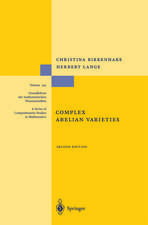Geometric Invariant Theory for Polarized Curves: Lecture Notes in Mathematics, cartea 2122
Autor Gilberto Bini, Fabio Felici, Margarida Melo, Filippo Vivianien Limba Engleză Paperback – 19 noi 2014
Din seria Lecture Notes in Mathematics
- 17%
 Preț: 360.42 lei
Preț: 360.42 lei -
 Preț: 459.92 lei
Preț: 459.92 lei -
 Preț: 121.41 lei
Preț: 121.41 lei -
 Preț: 175.68 lei
Preț: 175.68 lei -
 Preț: 197.00 lei
Preț: 197.00 lei -
 Preț: 279.76 lei
Preț: 279.76 lei -
 Preț: 477.65 lei
Preț: 477.65 lei - 17%
 Preț: 361.88 lei
Preț: 361.88 lei -
 Preț: 252.37 lei
Preț: 252.37 lei -
 Preț: 353.99 lei
Preț: 353.99 lei -
 Preț: 138.88 lei
Preț: 138.88 lei -
 Preț: 152.61 lei
Preț: 152.61 lei -
 Preț: 116.67 lei
Preț: 116.67 lei -
 Preț: 102.77 lei
Preț: 102.77 lei - 17%
 Preț: 365.52 lei
Preț: 365.52 lei -
 Preț: 396.75 lei
Preț: 396.75 lei - 17%
 Preț: 362.12 lei
Preț: 362.12 lei -
 Preț: 396.11 lei
Preț: 396.11 lei -
 Preț: 357.78 lei
Preț: 357.78 lei - 17%
 Preț: 362.31 lei
Preț: 362.31 lei -
 Preț: 403.80 lei
Preț: 403.80 lei - 17%
 Preț: 361.70 lei
Preț: 361.70 lei -
 Preț: 499.87 lei
Preț: 499.87 lei -
 Preț: 457.03 lei
Preț: 457.03 lei -
 Preț: 395.90 lei
Preț: 395.90 lei -
 Preț: 459.00 lei
Preț: 459.00 lei -
 Preț: 487.57 lei
Preț: 487.57 lei -
 Preț: 424.01 lei
Preț: 424.01 lei -
 Preț: 487.57 lei
Preț: 487.57 lei -
 Preț: 330.55 lei
Preț: 330.55 lei -
 Preț: 325.75 lei
Preț: 325.75 lei -
 Preț: 350.30 lei
Preț: 350.30 lei -
 Preț: 331.31 lei
Preț: 331.31 lei -
 Preț: 408.37 lei
Preț: 408.37 lei -
 Preț: 328.25 lei
Preț: 328.25 lei -
 Preț: 421.28 lei
Preț: 421.28 lei -
 Preț: 276.08 lei
Preț: 276.08 lei -
 Preț: 424.60 lei
Preț: 424.60 lei -
 Preț: 422.05 lei
Preț: 422.05 lei -
 Preț: 505.01 lei
Preț: 505.01 lei -
 Preț: 422.05 lei
Preț: 422.05 lei -
 Preț: 274.93 lei
Preț: 274.93 lei -
 Preț: 335.16 lei
Preț: 335.16 lei -
 Preț: 422.27 lei
Preț: 422.27 lei -
 Preț: 497.49 lei
Preț: 497.49 lei -
 Preț: 272.81 lei
Preț: 272.81 lei -
 Preț: 428.04 lei
Preț: 428.04 lei -
 Preț: 376.22 lei
Preț: 376.22 lei -
 Preț: 427.10 lei
Preț: 427.10 lei -
 Preț: 325.92 lei
Preț: 325.92 lei
Preț: 350.89 lei
Nou
Puncte Express: 526
Preț estimativ în valută:
67.14€ • 70.28$ • 55.88£
67.14€ • 70.28$ • 55.88£
Carte tipărită la comandă
Livrare economică 31 martie-14 aprilie
Preluare comenzi: 021 569.72.76
Specificații
ISBN-13: 9783319113364
ISBN-10: 3319113364
Pagini: 160
Ilustrații: X, 211 p. 17 illus.
Dimensiuni: 155 x 235 x 17 mm
Greutate: 0.32 kg
Ediția:2014
Editura: Springer International Publishing
Colecția Springer
Seria Lecture Notes in Mathematics
Locul publicării:Cham, Switzerland
ISBN-10: 3319113364
Pagini: 160
Ilustrații: X, 211 p. 17 illus.
Dimensiuni: 155 x 235 x 17 mm
Greutate: 0.32 kg
Ediția:2014
Editura: Springer International Publishing
Colecția Springer
Seria Lecture Notes in Mathematics
Locul publicării:Cham, Switzerland
Public țintă
ResearchCuprins
Introduction.- Singular Curves.- Combinatorial Results.- Preliminaries on GIT.- Potential Pseudo-stability Theorem.- Stabilizer Subgroups.- Behavior at the Extremes of the Basic Inequality.- A Criterion of Stability for Tails.- Elliptic Tails and Tacnodes with a Line.- A Strati_cation of the Semistable Locus.- Semistable, Polystable and Stable Points (part I).- Stability of Elliptic Tails.- Semistable, Polystable and Stable Points (part II).- Geometric Properties of the GIT Quotient.- Extra Components of the GIT Quotient.- Compacti_cations of the Universal Jacobian.- Appendix: Positivity Properties of Balanced Line Bundles.
Textul de pe ultima copertă
We investigate GIT quotients of polarized curves. More specifically, we study the GIT problem for the Hilbert and Chow schemes of curves of degree d and genus g in a projective space of dimension d-g, as d decreases with respect to g. We prove that the first three values of d at which the GIT quotients change are given by d=a(2g-2) where a=2, 3.5, 4. We show that, for a>4, L. Caporaso's results hold true for both Hilbert and Chow semistability. If 3.5<a<4, the Hilbert semistable locus coincides with the Chow semistable locus and it maps to the moduli stack of weakly-pseudo-stable curves. If 2<a<3.5, the Hilbert and Chow semistable loci coincide and they map to the moduli stack of pseudo-stable curves. We also analyze in detail the critical values a=3.5 and a=4, where the Hilbert semistable locus is strictly smaller than the Chow semistable locus. As an application, we obtain three compactications of the universal Jacobian over the moduli space of stable curves, weakly-pseudo-stable curves and pseudo-stable curves, respectively.
Caracteristici
An introduction to the techniques of Geometric Invariant Theory via a detailed analysis of the GIT problem for polarized curves An introduction to the problem of compactifying moduli spaces through an interpretation of the output of the GIT analysis An introduction to the rich theory of compactified Jacobians for singular curves via three explicit examples A detailed description of the quotient stacks associated to the different GIT quotients, illustrating the interplay between these two techniques















